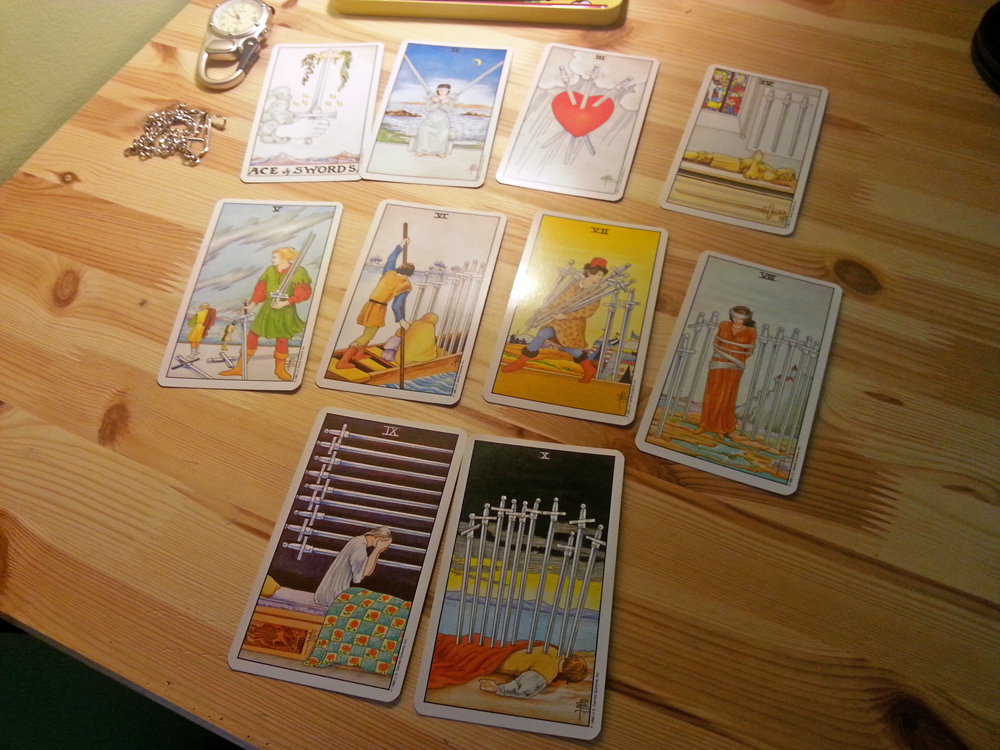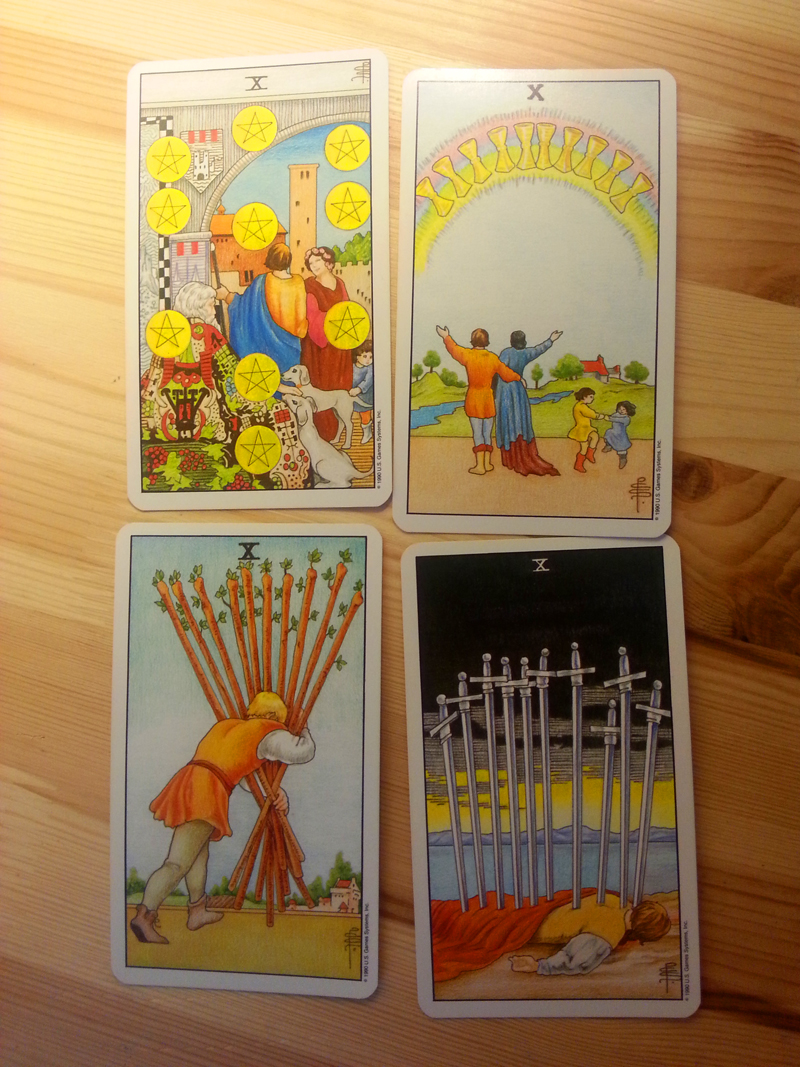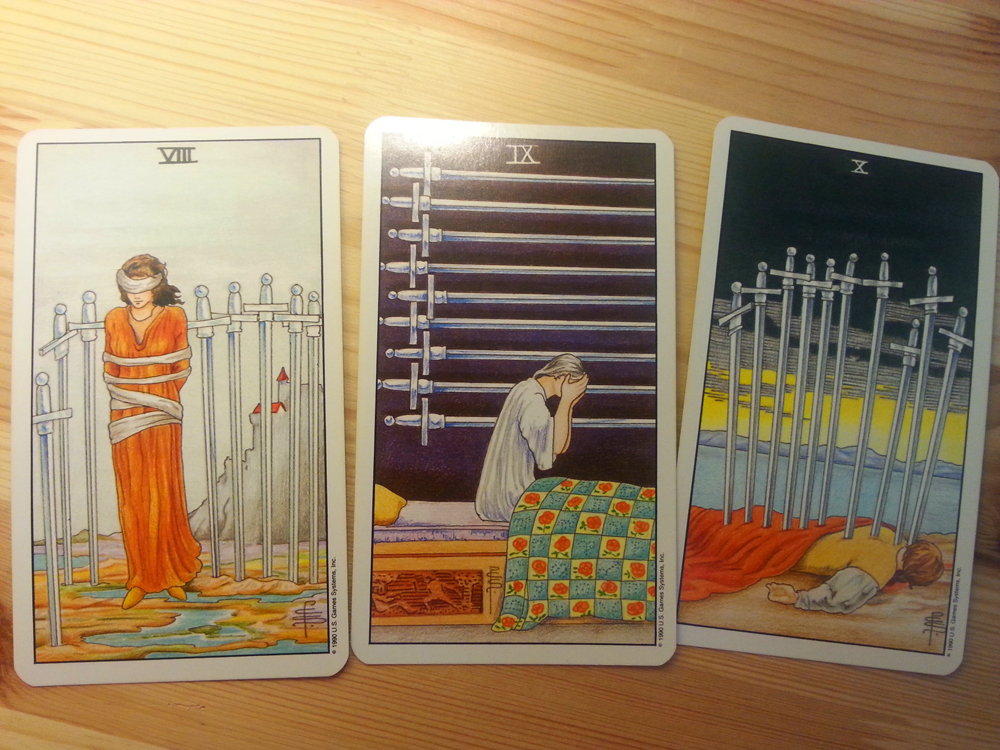 Of the four minor arcana suits, Swords tends to have more than its fair share of dark and scary cards. Where to even start? The confusion of the blindfolded figure in Two who balances crossed swords on her shoulders, the pain of the swords in Three piercing a heart, the unethical behavior of Five and Seven, the bondage and torment of Eight and Nine, the black skies and over-the-top back-stabbing in Ten? When I first took up tarot cards as a teenager these cards creeped me out, but I didn’t know why. Now that I’m older, with some Buddhist teachings and painful but valuable life experiences under my belt, I have a better understanding of of the perils of this suit. Swords are the suit that represents intellect, reason, logic, and empirical knowledge the the product of these things: our beliefs.
Of the four minor arcana suits, Swords tends to have more than its fair share of dark and scary cards. Where to even start? The confusion of the blindfolded figure in Two who balances crossed swords on her shoulders, the pain of the swords in Three piercing a heart, the unethical behavior of Five and Seven, the bondage and torment of Eight and Nine, the black skies and over-the-top back-stabbing in Ten? When I first took up tarot cards as a teenager these cards creeped me out, but I didn’t know why. Now that I’m older, with some Buddhist teachings and painful but valuable life experiences under my belt, I have a better understanding of of the perils of this suit. Swords are the suit that represents intellect, reason, logic, and empirical knowledge the the product of these things: our beliefs.
Thinking about the suit of swords brought to mind one of the Buddha’s more famous teachings, the simile of the two arrows. You can read it here, but it goes something like this: Suppose you were shot with an arrow–of course it would be incredibly painful. But what if shortly afterward you were shot with a second arrow in the same place? The pain would increase enormously. The thing is, the Buddha says that this scenario happens all the time in our lives. We get shot with arrows–teeny little arrows like missing the bus, big arrows like the betrayal by a partner–and that’s just part of life. Getting shot with an arrow from time to time is simply a normal part of existence. But the thing is, we then proceed to shoot ourselves with a second arrow.
How does this happen? One thing I have finally noticed in the past few months, which came to me while I was dealing with the Big Family Emergency in the fall, is that there is no pain that is not felt by the body. Even “mental” pain, like tormenting thoughts and emotions, make us feel bad in the body. Accordingly, there is no such thing as purely mental pain. Figuring this out was such a relief, because I realized that when I feel pain, even if it’s coming from a mental source, I can take care of it by attending to my body–relaxing, breathing, being gentle to myself. However, I spent most of my life ignoring the bodily manifestation of pain and assuming that mental/emotional pain is a problem to be solved by the intellect.
So the first arrow is the stuff that happens to us, some of which, like illness or injury, is just plain ol’ bodily pain. Some of it is pain that comes from ideas and emotions. In either case, this is the first arrow and its site is in the body. The second arrow hits when we begin to make a mental problem out of our pain. The Buddha’s teaching, then, is to always return to the body and let go of the mental habits. Easier said than done, but it can be done. I’ve come a long way in dealing with my second arrows over the past three years.
How would the two arrows work in everyday life? Say you’re at a party and you make a minor faux pas, like saying something kind of dorky right as there happens to be a lull in the conversation. It’s embarrassing, sure. That initial embarrassment lasts for a few seconds or minutes, but people start talking again and the incident is behind you. However, if you’re anything like…well…me and most people I know, the pain only begins there. For hours, days, and weeks afterward, your mind circles back to that moment. You say hurtful things to yourself like, “Why am I always such an idiot?” or “This is why no one likes me” and believe them wholeheartedly. Any topic of thought remotely related to the conversation, the party, or the people who were present brings up painful emotions that you try to stifle. Pretty soon, your humiliation and shame are so great that you avoid the people who were at the party. Only a few weeks or months later when you run into one on the street and they say they’re glad to see you and ask where you’ve been do you realize that they probably forgot your embarrassing comment and you have been essentially hating and punishing yourself for no reason.
The the initial few seconds or minutes of the embarrassment are the first arrow. All the rest of that crap? That’s the second arrow–it’s what we do to ourselves. Psychologists would call it a pattern of of rumination and such patterns are deeply engrained, particularly for people experiencing long-term self-hatred or depression. Note that the cycles of rumination have their source in, and are fed by, the intellect. A great description of the downward spiral of rumination is in The Mindful Way through Depression, a book I have found extremely helpful. Embarrassment is an emotion–one which has a strong bodily response in terms of tightening muscles, making blood flow to the face, etc. Experiencing that emotion and watching it die is the first arrow. The second arrow hits when we take up that emotion with the intellect. We recall the incident over and over, wondering what each person thought of us. We visualize what we would have done differently. We ask ourselves questions like, “What’s wrong with me?” and try to figure them out as if they were an intellectual puzzle. As rumination continues, negative emotions and bodily responses increase. They’re painful and we want to avoid them, so we retreat to the intellect again to “solve” the “problem,” or retreat to food, intoxicants, or media to escape them.
So let’s come back to the swords. It’s only after having lived through this experience and examined it through the perspectives of Buddhist teachings and psychotherapy that I now truly understand why the swords of intellect are so damn scary. In particular, I look at Eight through Ten and know that I lived through it. In Eight the woman is in a scary place, but she keeps herself there. She thinks she is bound by her thoughts, but her bonds are loose; if she saw her situation clearly, she could walk away. Thinking that she is bound by these negative thoughts, she won’t reach up to remove the blindfold In Nine, the person is haunted by ruminative thoughts, which hang over them threateningly. Again, they could just get out of bed but the pain keeps them rooted in place. In Ten, the cycle is finally complete. It’s that moment when the pain is so all-encompassing that we realize we must find a way out or be killed by the ruminative intellect.
I am glad I lived through that cycle and was able to learn from it. My depression was not on the more severe side of the spectrum–I never contemplated suicide, was able to keep up my day-to-day functioning (albeit miserably), and was able to find a cure through a combination of mindfulness and talk therapy–but it was one of the most painful times of my life.
 I think the dangers of intellect and reason become clearer when we look at the tens from all of the suits since they represent completion or fulfillment of the things they represent. For Pentacles and Cups, tens represent abundance and contentment. Why? Because materiality and emotions, when used properly, lead to happiness. To me the Ten of Pentacles isn’t just about having stuff, it’s about living a life that’s deeply in touch with the here and now; it’s about seeing life through the lens of abundance and being in touch with nature. The Ten of Cups isn’t about letting emotion run your life, it’s about being in touch with emotions, taking care of them when they need to be taken care of, and letting them guide you when appropriate. Wands are a little different. The fulfillment of Wands–creative energy–can be both an achievement and a burden. You’ve made something! Awesome! But now you’re responsible for it and have to take care of it, which in a sense means that your work is not over.
I think the dangers of intellect and reason become clearer when we look at the tens from all of the suits since they represent completion or fulfillment of the things they represent. For Pentacles and Cups, tens represent abundance and contentment. Why? Because materiality and emotions, when used properly, lead to happiness. To me the Ten of Pentacles isn’t just about having stuff, it’s about living a life that’s deeply in touch with the here and now; it’s about seeing life through the lens of abundance and being in touch with nature. The Ten of Cups isn’t about letting emotion run your life, it’s about being in touch with emotions, taking care of them when they need to be taken care of, and letting them guide you when appropriate. Wands are a little different. The fulfillment of Wands–creative energy–can be both an achievement and a burden. You’ve made something! Awesome! But now you’re responsible for it and have to take care of it, which in a sense means that your work is not over.
And the Ten of Swords? On the face of it, the fulfillment of the intellect looks like the worst thing imaginable. And anyone who has lived through a period of life in which ruminative patterns ruled the mind knows that it’s true. After I began to pull out of my depression a couple of years ago, I came up with my definition for depression: “Life lived 100% inside the head.” That’s because everything–everything–that happens is filtered through the warped lens of your ruminative thoughts.
The card itself points to the gifts of this position, though. The black clouds are lifting and a new horizon is not only visible, but bright. The Ten of Swords is about beating a dead horse, going as far with an idea or a thought pattern as you can possibly go, and sometimes the dead horse is yourself. But it also represents the moment when things simply can’t get any worse and the uphill journey begins.
As a graduate student and thus a knowledge-worker, I’ve become happier and happier as I’ve recognized the proper role of the intellect. The intellect, as the saying goes, is a good servant but a poor master. A local doctor of Chinese medicine came to visit our temple and said, “If you use your intellect for work, make your living by it but don’t make a habit out of it.” Setting every aspect of our lives in front of reason and intellect as a “problem” to be solved is dangerous. And yet that’s what’s expected of us on a society that often rejects emotion, intuition, and faith. (Of course, the latter three can also get out of hand, but when used properly they balance the intellect.) One of my favorite quotes from Michel Foucault is, “Knowledge is not for knowing; knowledge is for cutting.” This is so true,. Knowledge/intellect can cut to the the root of a problem or it can cut us to pieces. The result depends upon how we use it.
I very much appreciate that tarot, a Western system of thought, takes this attitude toward the intellect. Sometimes it still feels like we’re living in the Enlightenment and that one is given the choice of cleaving entirely to reason and the intellect, or rejecting them in favor of dogmatism and blind faith. It’s good to know that there is a Western wisdom tradition that simply doesn’t reject the intellect, but sees it for what it is: a double-edged sword.

Leave a Reply